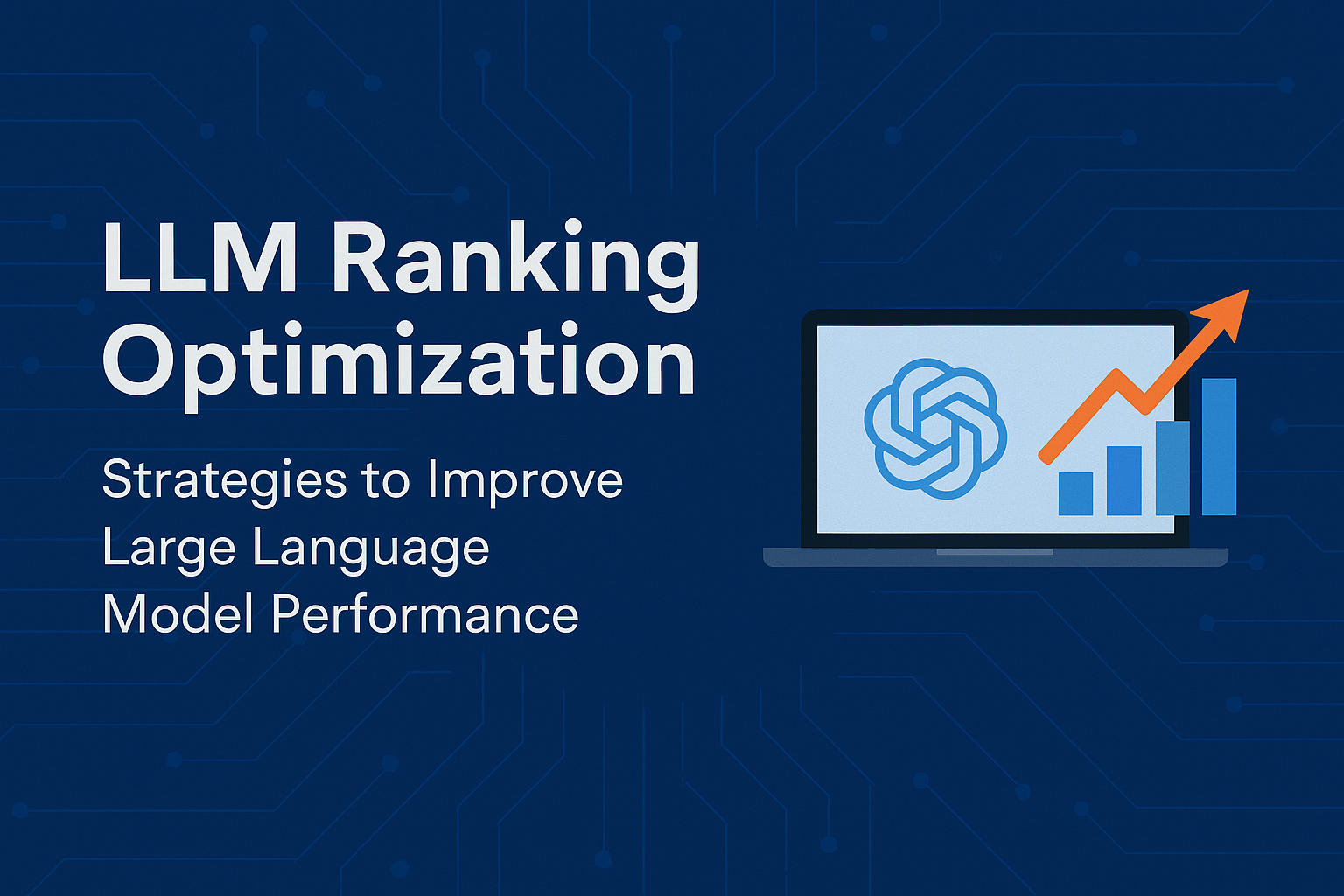Large Language Models (LLMs) have revolutionized natural language processing, but their effectiveness hinges on more than just massive datasets and transformer architectures. For an LLM to deliver accurate, relevant, and useful results, its ability to rank outputs intelligently is critical. This is where LLM ranking optimization comes into play.
In this post, we’ll explore the techniques used to improve LLM performance by enhancing ranking mechanisms, such as reinforcement learning from human feedback (RLHF), pairwise comparisons, reward modeling, and instruction tuning.
What Is LLM Ranking Optimization?
LLM ranking optimization refers to the process of training or fine-tuning a language model to order its responses based on relevance, accuracy, or alignment with user intent. Instead of producing all plausible outputs equally, the model learns to prioritize the best possible response.
This approach improves:
- Relevance of answers
- Factual accuracy
- Safety and policy alignment
- Task-specific performance (e.g., summarization, translation)
Why Ranking Matters
Even with well-pretrained transformers, LLMs often generate multiple valid completions. The challenge lies in identifying which output best meets the user’s need. Without a ranking strategy, models might:
- Hallucinate incorrect facts
- Prioritize stylistically strong but irrelevant outputs
- Offer responses that violate safety guidelines
Ranking also affects trust. When users see inconsistent or illogical outputs, confidence in the model drops—even if most answers are correct. Optimizing ranking ensures that the most reliable, grounded response is delivered first.
Key Strategies for LLM Ranking Optimization
Reinforcement Learning from Human Feedback (RLHF)
One of the most foundational techniques, RLHF refines language models by aligning them with human preferences. It starts with supervised fine-tuning, then uses ranked outputs to train a reward model. Finally, policy optimization through reinforcement learning maximizes output quality.
Pairwise Comparison and Preference Modeling
Using human-annotated pairs of outputs, models learn what humans consider better. This pairwise feedback helps train reward models and directly guides tuning.
Direct Preference Optimization (DPO)
A newer approach that skips reward modeling by using gradients directly from preferences. It’s more sample-efficient and often easier to implement.
Instruction Tuning with Ranked Outputs
Extending instruction-tuned models with preference-based data yields highly aligned responses across a variety of tasks, from summarization to coding.
Iterative Fine-Tuning with Community Feedback
Deploying models with feedback collection mechanisms (e.g., upvotes, reactions) allows iterative refinement that aligns with evolving real-world needs.
Advanced Techniques: Beyond Basic Optimization
RAG-Based Hybrid Ranking (Retrieval-Augmented Generation)
Incorporating external data sources through retrieval pipelines lets models compare contextual evidence before ranking responses. Combining internal knowledge with dynamic document retrieval improves factuality.
- Use dual encoders to score retrieved passages
- Rank documents before synthesis
- Apply reranker models (e.g., Fusion-in-Decoder)
Multi-Objective Optimization
Sometimes ranking must balance multiple goals:
- Helpfulness vs. safety
- Fluency vs. factuality
- Conciseness vs. completeness
Multi-objective learning frameworks (like scalarized or Pareto-based RL) can integrate different loss signals.
Curriculum Learning for Ranking
Start with simple ranking tasks (e.g., binary comparisons) and progressively increase complexity (e.g., multi-turn dialogue coherence, multi-label ranking). This strategy leads to more stable convergence and better generalization.
Common Challenges in Ranking Optimization
1. Human Preference Variability
Preferences differ between annotators, tasks, and cultural contexts. To address this:
- Use aggregation techniques like majority vote or rank averaging
- Normalize labels across annotators
- Evaluate inter-annotator agreement (Cohen’s Kappa, Fleiss’ Kappa)
2. Scaling Annotation Efficiently
Manual labeling is expensive. Solutions include:
- Active learning to focus on uncertain outputs
- Weak supervision and synthetic labels
- Community feedback integration
3. Avoiding Overfitting to Rewards
Models can game reward signals. They may output responses that superficially align with preferences but lack depth. Solutions:
- Mix reward-optimized training with supervised fine-tuning
- Introduce diversity constraints
- Regularize with adversarial examples
Metrics to Evaluate Ranking Optimization Success
Quantitative:
- NDCG (Normalized Discounted Cumulative Gain)
- MRR (Mean Reciprocal Rank)
- Precision@k / Recall@k
- BLEU, ROUGE (task-specific)
Qualitative:
- Human satisfaction ratings
- Preference consistency over time
- Usefulness in downstream tasks (e.g., summarization, QA, sentiment classification)
Future Trends in LLM Ranking Optimization
Federated Feedback Collection
Distributing the feedback loop across users while preserving privacy ensures wider applicability and inclusivity.
Alignment with Values and Ethics
Models must not only perform well but also reflect ethical priorities. Expect more use of value learning, constitutional prompts, and cross-cultural evaluation.
Integration with AGI Alignment Efforts
Ranking optimization may play a foundational role in aligning general-purpose models with human intentions, critical for safe and scalable AI systems.
Tools and Frameworks for LLM Ranking Optimization
- TrlX – Reinforcement learning training toolkit from CarperAI
- OpenFeedback – Crowdsourced feedback system
- DPO (Direct Preference Optimization) – New gradient-based ranking technique
- Anthropic’s Constitutional AI – Rules-based preference modeling
Real-World Applications of LLM Ranking
Search Result Rewriting
LLMs generate summaries of ranked pages. Optimizing this flow means not just ranking documents, but also ranking summary phrasing.
Legal and Medical Decision Support
In fields with high accuracy requirements, LLMs must surface the most cautious, grounded, and evidence-backed output.
Chatbot Memory Recall
Ranking previous interactions helps models reference relevant past conversations, avoiding repetition or contradiction.
Social Media Monitoring
When summarizing or flagging content, LLMs use ranking to prioritize concerning trends, signals, or misinformation.
FAQ: LLM Ranking Optimization
To ensure that the best, most human-aligned response appears first—boosting usefulness and minimizing risk.
RLHF adds a reward-based optimization loop on top of supervised fine-tuning to align with human preferences.
Yes. Frameworks like TrlX, Hugging Face Transformers, and LoRA enable accessible preference training.
Collecting clean, diverse, and unbiased human preference data that reflects real-world use cases.
DPO uses gradient optimization directly from preference pairs—offering better sample efficiency and stability.
Through multi-objective optimization strategies such as weighted loss functions or Pareto optimization, models can handle trade-offs like fluency vs. factuality.
Human feedback is essential for adapting models to real-world use. It anchors alignment over time, especially when integrated through online or active learning.
Yes. By training models to prioritize grounded, verifiable outputs, ranking optimization helps reduce the tendency to hallucinate facts or invent information.
Standard metrics include NDCG, MRR, and human preference scores, but task-specific success rates (e.g., QA accuracy) also provide actionable insights.





